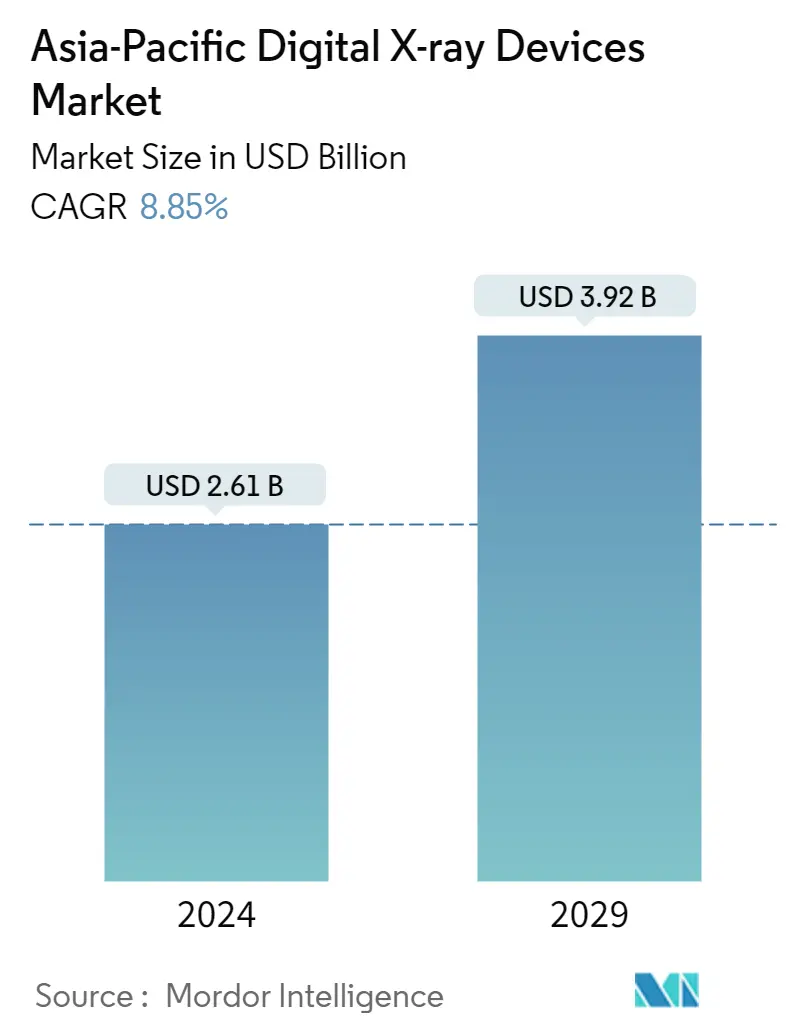Market Size of Asia-Pacific Digital X-ray Devices Industry

| Study Period | 2019 - 2029 |
| Base Year For Estimation | 2023 |
| Market Size (2024) | USD 2.61 Billion |
| Market Size (2029) | USD 3.92 Billion |
| CAGR (2024 - 2029) | 8.85 % |
| Market Concentration | Medium |
Major Players
*Disclaimer: Major Players sorted in no particular order |
Asia-Pacific Digital X-ray Devices Market Analysis
The Asia-Pacific Digital X-ray Devices Market size is estimated at USD 2.61 billion in 2024, and is expected to reach USD 3.92 billion by 2029, growing at a CAGR of 8.85% during the forecast period (2024-2029).
The market's growth is primarily driven by rising cases of orthopedic diseases and cancers, a surge in serious injuries, the superior benefits of digital X-ray systems compared to traditional ones, ongoing technological advancements, and robust product development initiatives.
The major advantages of digital imaging are affordable and easy accessibility. Hospitals can control their spending by lowering the cost of films, thereby requiring less storage space and employing less staff to manage the services and archives. For instance, as per a December 2022 article in the Research (Wash D.C.) Journal, the development of computed radiography has sparked a technological advancement for digital X-ray imaging with more accurate and immediate information. Compared to traditional X-rays, digital X-rays expose patients to about 70% to 80% less radiation. Digital X-rays are expected to drive the market's growth during the forecast period due to their numerous advantages, which may significantly improve the long-term health of patients, particularly pregnant women and those with existing medical conditions, consequently enhancing safety.
Due to the increase in the number of dental disorders, cardiac disorders, and cancers, especially breast cancer, there is an increased demand for digital ray devices globally. For instance, according to the June 2024 updates from the Australian Institutes of Health and Welfare report, in 2023, Australians lost an estimated 666,000 years of healthy life (DALY) due to all forms of cardiovascular disease (CVD), equivalent to 25.1 per 1,000 people. Thus, the high burden of cardiovascular diseases is expected to increase the demand for X-ray devices for effective diagnosis, thereby boosting market growth.
Key players are forming partnerships and collaborations and receiving increasing product approvals and technology advancements, all of which contribute to the growth of the market. For instance, in February 2023, Carestream Health India unveiled its latest innovation, the 'Carestream Motion Mobile X-ray system,' during the Indian Radiology and Imaging Association (IRIA) meeting in Amritsar. This cutting-edge system is tailored for a comprehensive range of general radiography examinations. Notably, its portability shines, allowing seamless navigation even in confined areas. Boasting an articulating arm and tube head, the system prioritizes visibility and user-friendliness. Such a launch of highly effective portable devices for imaging applications is anticipated to increase the demand for digital X-ray devices and drive market growth.
Thus, the aforementioned factors, such as the technological advancements in digital X-ray products and the high prevalence of cardiovascular diseases, are augmenting the growth of the digital X-ray devices market. However, the high installation and device costs, along with the rise in the use of refurbished devices, are expected to restrain market growth.
Asia-Pacific Digital X-ray Devices Industry Segmentation
Digital X-ray or digital radiography is a form of X-ray imaging in which digital X-ray sensors are used instead of traditional photographic films. This has the added advantage of time efficiency and the ability to transfer images digitally and enhance them for better visibility.
Digital x-ray imaging has high demand, as it requires less radiation exposure than traditional X-rays. The digital x-ray devices market is segmented by portability, application, end user, and geography. By portability, the market is segmented into fixed systems and portable systems. By application, the market is segmented as orthopedic, chest imaging, dental, and other applications. By end user, the market is segmented as hospitals, diagnostic centers, and other end users. By geography, the market is segmented into China, Japan, India, Australia, South Korea, and Rest of Asia-Pacific.
The report offers the value (USD) for the above segments.
| By Portability | |
| Fixed Systems | |
| Portable Systems |
| By Application | |
| Orthopedic | |
| Chest Imaging | |
| Dental | |
| Other Applications |
| By End User | |
| Hospitals | |
| Diagnostic Centers | |
| Other End Users |
| By Geography | |
| China | |
| Japan | |
| India | |
| Australia | |
| South Korea | |
| Rest of Asia-Pacific |
Asia-Pacific Digital X-ray Devices Market Size Summary
The Asia-Pacific digital X-ray devices market is poised for significant growth, driven by the increasing prevalence of orthopedic diseases, cancers, and serious injuries. The transition from traditional to digital X-ray systems is fueled by the superior benefits of digital imaging, such as reduced radiation exposure and cost-effectiveness. Technological advancements, like computed radiography, have enhanced the accuracy and immediacy of diagnostic information, further propelling market expansion. The demand for digital X-ray devices is also bolstered by the rising incidence of dental and cardiac disorders, particularly cardiovascular diseases, which necessitate effective diagnostic tools. Key industry players are actively engaging in partnerships, collaborations, and product innovations to strengthen their market presence and meet the growing demand.
The market is characterized by the introduction of portable X-ray devices, which offer significant advantages in terms of patient mobility and cost reduction. These devices are particularly beneficial in healthcare settings where patient transport is challenging, providing quick and efficient diagnostic capabilities. The geriatric population in countries like India, with its high prevalence of orthopedic and dental conditions, is a major contributor to market growth. Local players are investing in product development to cater to this demographic, supported by government initiatives to expand medical device manufacturing. The market is moderately consolidated, with major global players like Canon Inc., Fujifilm Holdings Corporation, and Siemens AG competing through innovative product launches and strategic partnerships to capture emerging market opportunities.
Asia-Pacific Digital X-ray Devices Market Size - Table of Contents
-
1. MARKET DYNAMICS
-
1.1 Market Overview
-
1.2 Market Drivers
-
1.2.1 Rising Burden of Diseases Requiring Diagnosis
-
1.2.2 Advantages over Conventional X-rays and Technological Advancements
-
-
1.3 Market Restraints
-
1.3.1 High Cost Associated with Device Installation
-
-
1.4 Porter's Five Forces Analysis
-
1.4.1 Threat of New Entrants
-
1.4.2 Bargaining Power of Buyers/Consumers
-
1.4.3 Bargaining Power of Suppliers
-
1.4.4 Threat of Substitute Products
-
1.4.5 Intensity of Competitive Rivalry
-
-
-
2. MARKET SEGMENTATION (Market Size by Value - USD)
-
2.1 By Portability
-
2.1.1 Fixed Systems
-
2.1.2 Portable Systems
-
-
2.2 By Application
-
2.2.1 Orthopedic
-
2.2.2 Chest Imaging
-
2.2.3 Dental
-
2.2.4 Other Applications
-
-
2.3 By End User
-
2.3.1 Hospitals
-
2.3.2 Diagnostic Centers
-
2.3.3 Other End Users
-
-
2.4 By Geography
-
2.4.1 China
-
2.4.2 Japan
-
2.4.3 India
-
2.4.4 Australia
-
2.4.5 South Korea
-
2.4.6 Rest of Asia-Pacific
-
-
Asia-Pacific Digital X-ray Devices Market Size FAQs
How big is the Asia-Pacific Digital X-ray Devices Market?
The Asia-Pacific Digital X-ray Devices Market size is expected to reach USD 2.61 billion in 2024 and grow at a CAGR of 8.85% to reach USD 3.92 billion by 2029.
What is the current Asia-Pacific Digital X-ray Devices Market size?
In 2024, the Asia-Pacific Digital X-ray Devices Market size is expected to reach USD 2.61 billion.

